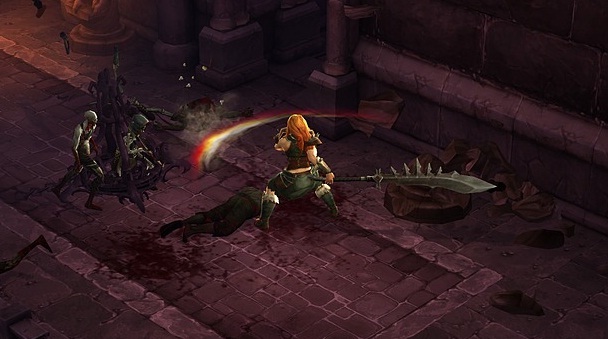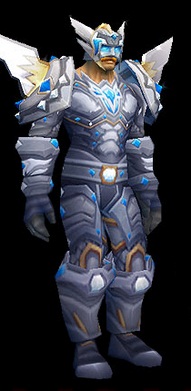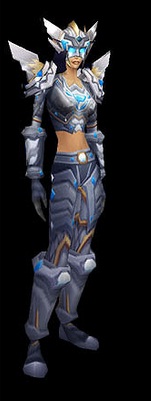After twelve years since the Lord of Terror was unleashed, it’s finally official: Diablo III will be raising hell on May 15. All I’ve ever really wanted in life is a co-op hack-and-slash dungeon crawler, so I was excited for this game from the get-go. But after spending a little time poking around on Diablo III’s official website, I’m really excited. Like, super excited. I am downright stoked. And it’s for a very simple reason:
All of the female characters look like someone I’d like to play.
As I mentioned back in January, Diablo III will be the first game in the series to offer full gender customization for player characters. This on its own is a welcome addition, but the fact that the female character models are so good has earned Blizzard a stamp of approval in my book. To help explain why, I’m going to put these new ladies into the greater context of how Blizzard has portrayed women throughout their games.
My enjoyment of a game is ultimately determined by a balancing act between two factors: does the gameplay appeal to me, and do I enjoy the story? A game with no story or even a bad story can still be fun, so long as it has engaging gameplay. On the flip side, I’m willing to forgive clunky gameplay mechanics if the story is really good. If a game has both solid gameplay and a great story, then I’ll be throwing my wallet at the developers behind it for years to come.
As far as that balance goes, Blizzard has the gameplay side down pat. I have played everything they’ve released since 1998, and even though I wouldn’t count anything they’ve made among my all-time favorites, I know I can always count on Blizzard for a good game. But in terms of story, I’ve often been underwhelmed by their female characters. I don’t need a game to have prominent female characters in order for me to get into it, but I do want it to be a place in which women feel welcome (to be fair, Blizzard does this better than many, but they’re still rather hit-or-miss). I don’t want to spend my free time in a world where women play second fiddle to the “real” heroes. That doesn’t mean that the protagonist has to be a woman, but it does mean that if the majority of characters are male, I’m going to notice the treatment of the female characters all the more.
That last point was something that affected how I felt towards my first Blizzard game, StarCraft. In StarCraft, women are rare, uniformly flirtatious, and only exist in support roles. The exception, of course, is Kerrigan, who is one of the most memorable video game villains to date. I was in my early teens when I first played StarCraft, and though I thought it was cool, it didn’t really capture my interest. My grade school notions about girl toys and boy toys were not far behind, and at the time, StarCraft felt like a game that did not belong to me. However, just a few years later, I played Warcraft III — which has very similar gameplay to StarCraft — to death. In hindsight, I think this has a lot to do with the inclusion of the matriarchal Night Elves. At that point in my life, playable female characters were scarce, and I didn’t care that these supposedly fierce, cunning warriors were charging around in purple mail bikinis and responding coyly when I clicked on them. Warcraft III was a game in which I could command an army of women riding on tigers. In those simpler times, that was the best I could hope for.
In terms of story, Diablo II treated player-controlled heroes relatively equally regardless of their gender, but there was a caveat. Character gender was predefined by class. You could play a tough, heroic-looking melee class, but only as a man. If you wanted to play a woman, you were stuck with a scantily-clad caster or archer. I didn’t want to play any of those. I wanted the tough, heroic-looking woman, but she was nowhere to be seen. The trend of assigning female characters solely to ranged and casting classes is hardly exclusive to Blizzard, but it’s certainly one that they have embraced for a long time. As a teenager, this bothered me. Okay, it still bothers me, but nowadays, if I’m not offered gender customization, I’ve resigned to prioritizing class abilities over predetermined gender. In my formative years, that was a choice that I really wrestled with (if you’re curious, I went with the Amazon).
By design, World of Warcraft avoided delegating players into classes or genders by giving them the ability to create a fully customized character. Even so, it was clear that the developers didn’t see male characters and female characters in the same light. To show you what I mean, here’s the Tier 3 Paladin set on a male character:
Now here’s the exact same set of armor on a female character.
If you’ve never seen an armor set disparity like this in WoW, that’s because the female armor has improved considerably throughout the expansions. Midriffs and hot pants were common when I first started playing back in 2006, but by the time I quit three years later, most armor sets were identical between genders. Blizzard, it seemed, was finally taking their female players into account. I haven’t visited Azeroth since 2009, but my friends who still play tell me that the only well-ventilated armor sets to be found are a few lingering remnants in the oldest, un-updated areas like Outland. In other words, they’re not pieces that you are likely to either find or use.
Despite this positive development, it was clear that Blizzard still had some wrinkles to iron out. The beta for WoW’s Cataclysm expansion introduced the Worgen race, which kicked off a debate over whether or not the female Worgen was too pretty or too ugly (it seems that “just right” was not on the table). The result was an ever-changing character model and a fanbase that remains divided on the topic (by comparison, the recently unveiled female Pandaren model for the upcoming Mists of Pandaria expansion has had no such troubles, and has been generally well received). Meanwhile, the single-player storyline in StarCraft II was criticized for effectively downgrading Kerrigan — again, one of the lone women in the StarCraft universe — from complex villain to damsel in distress. As is the case with many developers, gender portrayal is an area that Blizzard still struggles with. Evolution is never easy.
So while it’s too early to say how Diablo III will measure up, the female character models shown thus far have me feeling very encouraged. For starters, they are all wearing plausible armor. Their stomachs are covered. The only one who looks a bit waifish is the Wizard, which makes sense, and even she looks like she can tear it up. But the best of the bunch, in my opinion, is the Barbarian. She’s broad-shouldered. She’s buff. She’s got big, muscular thighs, which is exactly what you need if you’re going to be swinging an axe all day. And before you scoff at her bare legs, take note of what her male counterpart is wearing. This armor isn’t meant to be revealing; it’s meant to portray a particular culture. If you’re going to have armor that doesn’t cover a character from head to toe, this is exactly the way to do it. I believe this armor. I believe this character. This is a woman whose physical appearance meshes with the narrative context in which she is presented. Really, that’s all I want to see in a character model, and to find it in Diablo III was a pleasant surprise. Granted, the way your character is dressed in the game will depend on what armor you equip, but the fact that this is the public image they decided to give these women is heartening.
Are the designs perfect? No. Are the starting outfits for the Demon Hunter and the Wizard a bit irksome? Yes. But if we look at these character designs in comparison to the last fourteen years of Blizzard titles, it’s clear that things are continuing to improve for their female characters. And that’s something I can definitely get behind.
Though having the option to play a badass lady makes me feel welcome right off the bat, the game’s inclusiveness will ultimately be determined by the NPCs. It’s too early to know how Diablo III will measure up to its predecessors, but there are a few videos that have me intrigued. The two game cinematics that have been released (here and here) focus heavily on a new character, Leah (voiced by the venerable Jennifer Hale, no less). There’s a lot of speculation as to what role she will actually play in the story, but given how accustomed I’ve become to sexualized female characters in Blizzard’s promotional materials, my curiosity is piqued by how prominently modest, bookish Leah is being featured.
Even more promising is the trailer for the Demon Hunter class. Yes, I know, the high-heeled boots made me groan, too. But if you can look beyond the impractical footwear, there’s something interesting at work in this video. Here we have the standard trope of the frightened female victim becoming inspired to fight after seeing her rescuer in action, only this time, it’s another woman doing the rescuing.
May 15. My hopes are high. I can’t wait to see how this one plays out.
Becky Chambers is a freelance writer and a full-time geek. She blogs over at Other Scribbles.











Published: Apr 2, 2012 12:30 pm